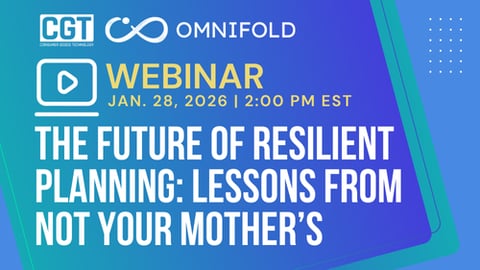Demand Planning Is All About Who You Are, Not Just What You Do
These days, when I get calls from consumer packaged goods (CPG) executives or demand planners, it’s typically because they can’t match supply to actual demand. Many have already replaced demand planning and forecasting systems, hoping an upgrade would give them the insights they need to finally right-size their stock and deliver on time, in full, every time.
Some have even worked with customers to connect ordering and inventory management systems so purchase requests could be reconciled against current stock levels and production requirements could be better managed. Yet, they’re still falling short.
As the conversation continues, I realize they tried to dig themselves out of months of miscalculated forecasts and erroneous planning formulas with tactical troubleshooting that ultimately led them into a deeper hole.
[Read more: Overcoming AI Obstacles to Embrace Transformative Technology]
So, before we talk about the specific ways to improve their demand planning and forecasting accuracy, I remind them that no investment in technology is going to help if they don’t reframe their mindset and reinvent who they are as modern planning practitioners. It’s the same advice I would give you if you called.
If you want to get things right in today’s volatile market, you must evolve into a “smart planner” by…
1. Learning to live in the present.
Too many of today’s demand forecasting models are stuck in the past because too many planners believe that historical demand trends will be repeated the next month, season or year. But if you're always looking back, you can't see what's right in front of you. Likewise, looking too far into the future remains a gamble. So, we must get better at understanding what’s happening in the here and now and how that might influence buying habits and inventory needs over the next six, 12 or 24 weeks – not the next six, 12 or 24 months.
2. Seeing things from others’ perspective, namely your end consumers.
Talk to your neighbors, your family members, your colleagues. What is happening in their lives? How are they spending or saving right now? Holidays may not be celebrated the same way they have in the past, or they may be pulling back on certain purchases to save for others. Inflation is undoubtedly influencing demand, as people try to stretch the dollar as much as possible.
Will they buy less pasta next month than they did last month? Not necessarily. But we may continue to see preference for private-label brands increase and quantities purchased each shopping trip shrink. Then again, bulk buying might become more popular as people look for volume discounts on commonly used goods. But you won’t pick up on these signals if you’re only tuned into what’s happening in your bubble.
3. Changing how you do things.
One of the most prevalent qualities of a smart planner is their willingness to rewrite the book. I have said this verbatim before in other forums, but it bears repeating, “Old systems and forecasting models don’t work in a world where something new is disrupting the supply chain every day, and factoring in older consumer spend patterns without accounting for data anomalies, changing consumer patterns, and new demand signals will severely skew future forecasts.”
So, instead of just ripping and replacing systems, rip and replace – or at least refine – all processes that influence or tie into demand planning. Also, set up continuous and timely feedback loops with internal stakeholders and third parties who have a pulse on what’s happening in the world and can advise you on when “the old way” of doing things isn’t working or you’re misinterpreting demand signals.
Of course, you must embrace innovative technology tools, too.
[Related: A Future Redefined: 2022 Retail and Consumer Goods Analytics Study]
When I said that ripping and replacing systems wouldn’t solve your problems, I meant that exclusively relying on technology as “the solution” will leave you disappointed. You absolutely need the assistance of new artificial intelligence (AI) platforms to connect the dots from those feedback loops you’ve set up with in-house experts and third-party systems — to understand how current or upcoming pricing, merchandising, community, global, and even weather events will impact base demand or create an uplift. Plus, changing how you see and do things requires enhanced visibility and skillsets only attainable via technology.
In Other Words
You need AI-powered technology platforms to become the smart, connected planner you want to be — the person who can see, hear, and understand what’s happening in the world right now. Someone capable of creating a single, unified demand forecast that will enable you and your team to sense, predict and meet actual demand.
—David Kane, Senior Director, Solutions Strategy, Supply Chain, antuit.ai, a Zebra Technologies Company




